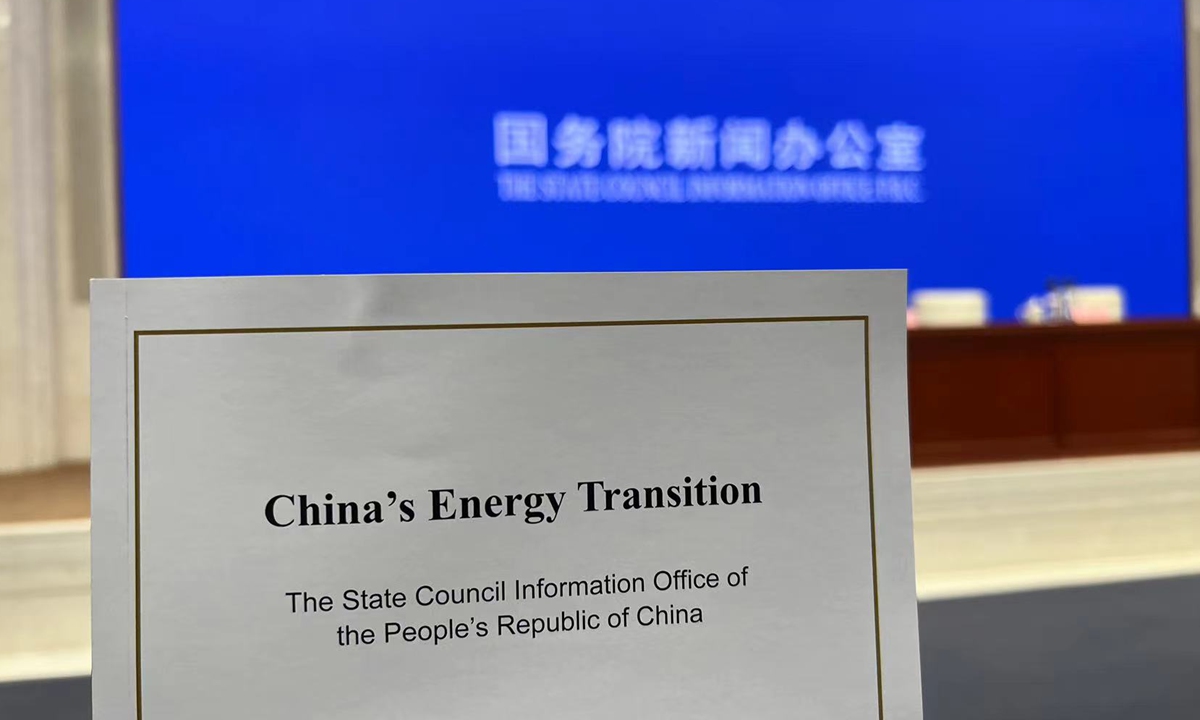China makes ‘notable progress’ in energy transition over the past decade; clean energy accounts for nearly 40% of total electricity generated: white paper

China's State Council Information Office on Thursday released a white paper titled "China's Energy Transition" to document the country's successful actions and historic achievements in this field over the past decade.
China has made notable progress in energy transition over the past decade, with “historical breakthroughs” achieved in green and low-carbon energy development and the country moving toward building a clean, diversified, secure and resilient energy supply system, according to a white paper titled “China’s Energy Transition” released on Thursday.The white paper listed an array of impressive figures that underscore milestones in China’s energy transition and highlight the country’s outstanding contribution to global efforts to address climate change in the past decade.
For example, electricity generated by clean energy in 2023 accounted for nearly 40 percent of the country’s total electricity generation. Also, China’s exports of wind and photovoltaic (PV) products last year helped other countries reduce carbon dioxide emissions by about 810 million tons, and the nation's new-energy industry has “added to the global energy supply and eased global inflation pressures.”
By taking proactive actions to advance its energy transition, China – as the world’s largest energy producer and consumer – is not only fulfilling its responsibility as a major country and contributing to a global community of shared future, but also demonstrating its commitment to keeping global energy industrial and supply chains open and stable, the white paper said.
It also stressed that China opposes all forms of unilateralism or protectionism, and rejects all forms of “decoupling” and the “small yard and high fence” approach, while calling for major countries to “act in a responsible manner by ensuring global energy security, promoting green development and maintaining market order.”
According to the white paper, China has been fast tracking clean energy development and there’s a growing share of green energy in China’s energy mix.
For example, the share of clean energy consumption reached 26.4 percent of China’s total energy use in 2023, up 10.9 percentage points from 2013. Meanwhile, by the end of 2023, China’s cumulative installed capacities of wind and PV power were an eleven-fold increase over the past decade.
Lin Boqiang, director of the China Center for Energy Economics Research at Xiamen University, told the Global Times that over the past decade, China has led the global energy transition, not only in the speed of its transformation but also in the expansion of new-energy production capacity and output. The world’s second-largest economy is steadily marching toward its “dual carbon” goal of reaching peak carbon emissions by 2030 and attaining carbon neutrality by 2060.
“China’s successful energy transition plays an exemplary role for developing countries and sets a global model,” Lin said. He noted the country’s significant contributions to the development of global wind power, solar photovoltaic energy and electric vehicles are well-recognized, with cost-effective equipment and large-scale supply offering many nations a low-cost pathway to their own energy transitions.
China’s green energy development has become an engine for global energy transition, the white paper said.
The white paper cited data from the International Energy Agency as saying that from 2014 to 2023, the global share of non-fossil fuels in energy consumption rose from 13.6 percent to 18.5 percent, with China contributing 45.2 percent to this increase. Over the past decade, the average cost per kilowatt-hour of global wind power projects has decreased by more than 60 percent, and PV power projects by more than 80 percent. The reductions are largely attributable to China’s efforts.
Observers said that these upbeat figures show that China’s global competitiveness in renewable energy comes from continuous innovation and a complete industrial chain. It also sounds the alarm to certain Western countries that have stepped up a relentless crackdown against China’s new-energy exports, warning them that “this politicization of economic issues would heavily hinder the global green transition, hinder energy structure optimization, and delay climate change efforts.”
The white paper also said thatdespite various forms of rising “green barriers” and more challenges, China upholds open and mutually beneficial cooperation, and is committed to keeping global energy industrial and supply chains stable and maintaining energy security in an open environment.
“China is ready to work with other countries to uphold the principle of equity and common but differentiated responsibilities and respective capabilities, while working toward the targets outlined by the Paris Agreement, as it helps to build a fair and rational global climate governance system directed toward cooperation and mutual benefit,” the white paper said.
It also urged developed countries to provide funding, technology and capacity-building support for renewable energy deployment in developing countries, and help address the dual challenges of energy supply security and the green and low-carbon energy transition.




